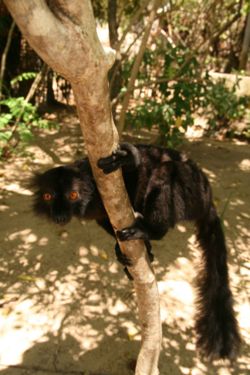Eulemur macaco (Black Lemur)

The black lemur Eulemur macaco macaco, a so called "true lemur", is a medium-sized quadrupedal Lemur. In the wild, it is found only on the island of Madagascar.
Description
The black lemur is a cathemeral Primate that has a head body length of approximately 39 – 45 cm and a tail length of around 50-65 cm[1][2][3]. Weight ranges between approximately 3 and 3.5 kg[3]. Males are typically dark chocolate brown to black, while females have golden-brown to chesnut colored backs and light colored bellies. The female's face is grey ot black, the crown a darker grey and the ears white tuffed [3]. The eyes of both sexes are orange [3].
Behaviour
Studies show significant variation in group size and territorial behaviour [2][3]. The black and white ruffed lemur moves mostly quadrupedally but is also an adept leaper[3]which can be reminiscent of the singing of some whale species.It has been noted that this species is possibly the only Primate to build nests exclusively for the birth of young[3]. It is highly adaptable to different habitats and group sizes range from 2 to 15 [3].

Diet
It is highly frugiverous but also eats seeds, leaves and nectar [2][3].
Geographical distribution
The black lemur may be found in tropical moist lowland and montane forested areas of northwestern Madagascar and on islands around Nose Be[3].
Status
The black lemur is considered to be endangered by the IUCN.
External links
References
- ↑ J. Fleagle (1998). Primate Adaptation and Evolution. Academic Press: New York.
- ↑ 2.0 2.1 2.2 F. Szalay and E. Delson (2001). Evolutionary History of the Primates. Academic Press, New York.
- ↑ 3.0 3.1 3.2 3.3 3.4 3.5 3.6 3.7 3.8 3.9 Mittermeier et al. (2006). Lemurs of Madagascar. Conservation International.